Text
Are You Familiar With The Influence Of Suspension On Motorcycle Performance?
Motorcycle suspension makes the bike good to work and feel. It makes a ride comfortable and helps keep the bike steady and simple to control when it go fast. If riders know suspension and how it changes the bike, they make good choices to improve their bikes.
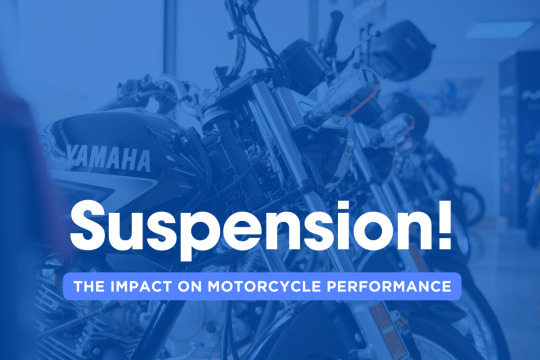
Motorcycles have front forks and a back shock absorber for their suspension. These parts soak up the bumps and shake from the road. They help the tires stay on the ground and make it stable for the rider. If you tune the suspension right, it can make turning, stopping, and riding smoother.
The type of riding conditions affects suspension performance a lot. Most street bikes have soft suspension for a smoother ride on streets. But off-road and sport bikes got a hard suspension for rough places and fast riding. Riders can change their suspension to make it how they like for better performance.
If you change the suspension parts on a motorcycle, it can make a big difference in how it works. Better shocks and forks help with control, less dive when braking, and more grip when you turn sharp or brake hard. You can get special suspension parts to match how much you weigh, how you ride, and what you want to improve on your bike.
You must take care of and tune the suspension system for the best work. You should often check and change the suspension's sag, rebound, and compress settings for a good and stable ride. Riders must look for any wear or damage on the suspension parts and change them when needed for safety and to keep them working well.
The effect of suspension on a motorcycle ride is very big. You need a good suspension for a ride that is smooth, steady, and in control, on the road or racing. If riders know about suspension and what it does to control and feel good, they can choose the best to make their ride better and their motorcycle can do its best.
0 notes
Text
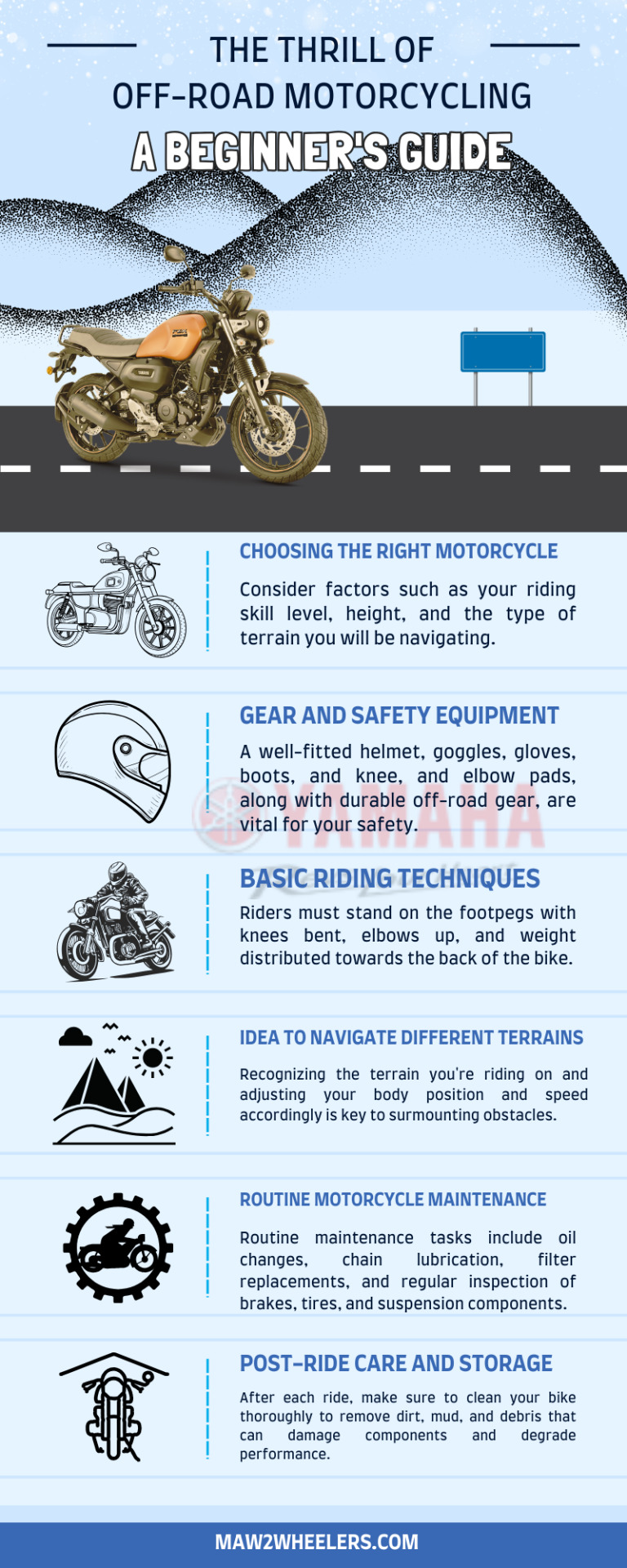
Off-road motorcycling is a thrilling and exhilarating way to explore the great outdoors on two wheels. Whether you're a beginner looking to dip your toes into the world of off-road riding or a seasoned rider wanting to refine your skills, this guide aims to provide you with valuable information to help you navigate through the rugged terrain with confidence. From choosing the right bike to mastering important techniques, get ready to begin an adventure like no other. Let's dive in and discover the excitement that off-road motorcycling has to offer!
0 notes
Text
5 Important Things to Consider Before Buying a New Motorcycle
Assuming you've done your homework and decked out yourself in biking fantasy, you've now got the enviable but potentially overwhelming task of locating a motorcycle that can best fit your requirements.

Your quest should ultimately lead you to a genre that meets your needs and interests, but it might take some soul-searching to find out which is the right for you. Here are some major aspects you should consider while getting new motorcycle.
Budget
This not only indicates the motorcycle purchase but in addition to its upkeep and operating expenses. Research concerning the price of spare parts of your preferred unit, and compare it with other motorcycle versions. Also, do notice that the larger the engine, the more fuel it gulps. Without budget, your motorcycle could wind up standing idle within your bedroom for weeks
Ergonomics
Making sure a motorcycle is ergonomically agreeable with your own body is trickier than it may initially sound. It's true that you can straddle a bike in a dealership or even take it on a check ride for a spin around the block. But sometimes what seems comfortable at first blush may turn out to be exhausting, or even painful, on longer rides; the topic is so possibly complex there are websites devoted to the art of contrasting body types to bike geometries. Is your knee bent too far? Are the handlebars a long reach on your arms? Being truthful with yourself and accurately estimating the long term effects of motorcycle comfort can entail guesswork, but finding your optimum physical match goes a long way towards ensuring long-term happiness with your new machine.
Design of a motorcycle:
It is a large reason a lot people get into motorcycles in the first place, along with a remarkable differentiator when it comes to your selection in bikes. Since fashion is subjective, the very best advice to offer is to pick a motorcycle that is so great looking, you cannot help but look over your shoulder as you walk off at a parking lot.
Fuel Economy:
Most riders could not care less about fuel economy. But new motorcycle buyers would be inaccurate to assume that all motorcycles are fuel sippers, especially when it comes to large engines. The simple fact that there's a big potential for fuel savings if the ideal motorcycle purchase is made indicates that it’s worth seriously considering mileage per kilometer figures before committing to a ride.
Engine Size:
Many men and women feel that a motorcycle's design, such as cruiser, sport bike, commuter or touring, clarifies the machine's energy. In fact, motorcycles style is not necessarily linked to engine power. The actual indicator is motor size, typically measured in cubic centimeters (CCs) of motor volume.
The first step you'll have to take into account is picking a motorcycle type, a procedure which involves a whole lot of alternatives since motorcycle manufacturers have created branches and sub-branches of the motorcycle genre. The largest distinction lies between on-road, dual-function and off-road motorcycles; once you move from there, you will still have a dizzying variety of alternatives and sub-specialties to pick from.
When there are a lot of reasons to opt for, the choice to buy your own bike is the second most significant commitment you can make towards becoming a committed motorcyclist, second only to learning how to ride. The above tips are a good start for newbies and remain equally significant reminders for long-time riders.
0 notes
Text

Winter is the tough time, primarily for machines. Like many of us, they want to hibernate. We should help them sustain, ease, and flourish during difficult times. Get more details on our motorcycle blog.
0 notes
Text
Motorcycle Engine Cooling Systems - Air vs. Liquid Cooling
Cooling the engine is very important for motorcycles. It helps the engine work well for longer. Motorcycles mainly use two kinds of cooling systems: air cooling and liquid cooling. Both types have good points and bad points. Riders need to know these. We will look at the differences between air cooling and liquid cooling in this blog post. We will see how each one works. We will also talk about how they affect how the motorcycle runs.
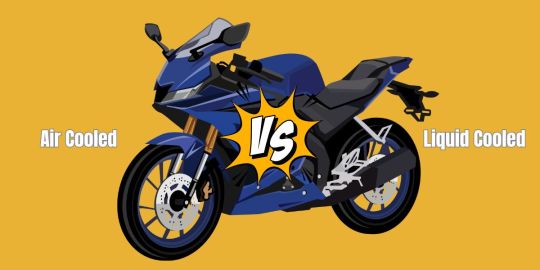
Types of Motorcycle Engine Cooling Systems
Your guide to understanding the different types of motorcycle engine cooling systems.
Air-Cooled Systems
Liquid-Cooled Systems
This breakdown will help you choose the right system for your motorcycle. You can like simple air-cooled systems or efficient liquid-cooled ones. Each has good points and bad points to think about.
Air-Cooled Systems
Simple and lightweight design
Less maintenance required
Exposed to external elements
May struggle in extreme temperatures
Suitable for classic and cruiser bikes
Liquid Cooled Systems
Efficient heat dissipation
Consistent engine temperature control
A complex system with more components
Higher initial cost
Air-Cooled Systems
Systems that use air-cooling do not use a liquid coolant such as water or antifreeze. They use the airflow around the engine to get rid of heat. These systems are simple and usually, you see them on old motorcycles or cruisers. They are light and do not need much maintenance. But, air-cooled engines can find it hard to keep the right temperature if the weather is very hot or cold, or if someone uses them too much for a long time.
Liquid-Cooled Systems
Cooling systems use liquid like water or antifreeze. We call these systems liquid-cooled systems. They have more parts such as a radiator, a water pump, and hoses. These parts help to control the temperature of the engine well. Liquid-cooled systems get rid of heat better. People who like high-performance motorcycles choose them for steady engine temperatures.
Also, engines that are liquid-cooled usually cost more at first. They might need more care than air-cooled systems. But the good working and control they give make them chosen by a lot of people who want depend on engine performance.
Air-Cooled Motorcycle Engines
Mechanism of Air Cooling
Motorcycles cool their engines using fins. Cooling ribs also helps motorcycles. The fins increase the engine surface area. A bigger surface lets the engine lose heat more easily. The motorcycle moves and air flows over the fins. Air flow takes away the engine heat. This keeps the engine temperature okay. It prevents the engine from overheating.
Advantages and Disadvantages
Motorcycle lovers like the simple design of air-cooled engines. These engines are usually lighter and cost less to make than liquid-cooled ones. But air-cooled engines do not cool as well, especially in fast motorcycles. They can get too hot and overheat when you use them a lot or in very hot weather.
It is very important to take care of an air-cooled motorcycle engine to make it last long. You must make sure it gets enough air and keep it clean, like the fins, so dirt does not stop it from cooling down.
Liquid-Cooled Motorcycle Engines
Mechanism of Liquid Cooling
Liquid cooling uses channels in the engine to move a mix of water and antifreeze. This mix takes in the heat from burning fuel. Next, a pump sends the hot coolant to the radiator at the motorcycle front. At the radiator, the mix lets out heat into the air. Then the mix flows back to cool the engine down.
Advantages and Disadvantages
Liquid cooling in motorcycle engines gives more stable temperatures. It also spreads out the heat better. It can keep the engine working well in different conditions. However liquid cooling systems often have more parts. They are heavier too. They might need more looking after than air cooling systems.
Motorcycle engines with liquid cooling are liked for making a lot of power without getting too hot. Even though they are more complicated and heavy, they work better and are more reliable. Riders and makers who want good performance go for liquid cooling.
Comparative Analysis
Performance
Maintenance and Durability
Performance Differences
Every person who loves motorcycles understands choosing air or liquid cooling is important for the bike's speed. Air-cooled engines are less heavy and not complicated, but liquid-cooled engines cool better. This means they give power more steadily and surely.
Maintenance and Durability
A rider needs to think about maintenance and how long things last when choosing air or water cooling systems. Air-cooling engines need less care and have fewer parts that can break. Water cooling systems need you to change the coolant often and can leak more easily.
How good the engine works and how long it lasts should help you choose between air or water cooling for your motorcycle engine. To make any cooling system last long and work well, you need to take good care of it.
Choosing the Right Cooling System
Factors to Consider
Think about important things when you pick air or liquid cooling for your bike engine. Consider what kind of riding you do. Think about the weather where you live. Look at how big and shaped your engine is. Decide how you like to keep your engine working well.
Riding style and frequency
Climate conditions
Engine size and layout
Maintenance preferences
This helps you choose well for your needs. It makes your motorcycle run best.
Recommendations for Different Riding Conditions
People who ride a lot in busy traffic or heat should use liquid cooling systems. Liquid cooling systems keep the engine temperature stable and help the engine last longer in hot weather.
Think about the places where you usually ride your motorcycle. Choose the best cooling system to make riding better and make your engine last longer.
Advances in Cooling System Technology
Innovative Cooling Solutions
Motorcycle engine cooling systems have been many times in the past years. Engineers always make new cooling ways to help motorcycles run better and use less fuel.
Impact on Engine Efficiency and Emissions
Motorcycle makers improve engines and cut emissions for the environment. They make cooling systems better to do this. The new cooling systems work better and meet tough rules.
Motorcycle cooling systems get new designs for better efficiency and fewer emissions. They use new tech like better airflow, top radiators, and smart cooling controls. These help engines work great and pollute less.
Wrap Up
People have argued for years about air-cooled and liquid-cooled motorcycle engines. Each system has good and bad points. Air cooling is easier but not so good at cooling. Liquid cooling is not so easy but controls temperature better. The rider's needs and likes decide which one is best. You must keep whichever system you pick in good condition for your motorcycle engine to last long and work well. Know how air and liquid cooling systems are different. It helps riders to choose well for their next motorcycle.
0 notes
Text
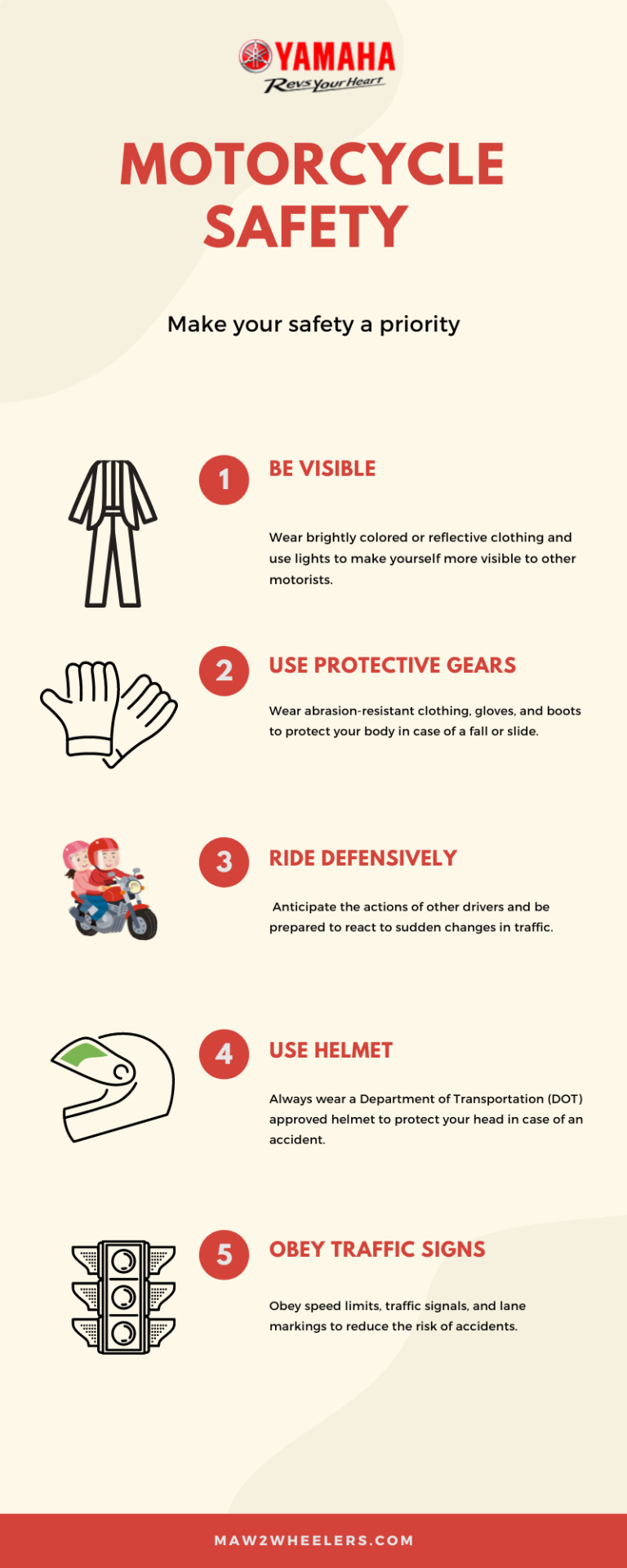
The infographic shows five main ideas for staying safe on a motorcycle. It says wearing a helmet and clothes that protect you are very important to keep you from getting hurt if you crash. You need to wear bright clothes and use lights so other drivers can see you well. Riders should also obey all traffic rules and be ready to deal with dangers while they riding.
0 notes
Text
After Market Vs Original Bike Parts (OEM)! What to use - Pros & Cons
You may have been asked by a service technician if you would want original (OEM) or parts from other sources. While the differences may not be obvious, they can make a difference in how each product is made. We will explain the differences among each below. Which is the best? For your motorcycle.
Bike owners have two options when it comes to replacing or fixing motorcycle parts. They can either take their bike to an independent shop or the dealer's automotive shop.
What are OEM Parts?
OEM stands for Original Equipment Manufacturer. These are accessories and parts for motorcycles made by the original manufacturer of the motorcycle, such as Bajaj, Honda, Yamaha, KTM, Ducati, etc. OEM motorcycle parts are original and brand new.
The Benefits of OEM Motorcycle Accessories
Confidence for Motorcycle: Some people believe that only original parts are the best way to keep their motorcycles running smoothly. Some even think that buying used parts for a motorcycle is better than buying new ones.
You can feel confident taking your motorcycle to the dealer for repair for OEM parts if you are happy with the bike and have confidence in the brand. There's no need to worry about the performance of the part or whether it will fit. The dealership will replace the worn or damaged part with a new part made by the same manufacturer. This guarantees the same quality.
Warranty: OEM parts are typically covered by a warranty. This is why some buyers will pay more for them. OEM manufacturers stand behind their products and their labor. They guarantee that if the part fails to work within the warranty period they will replace it or repair it.
Compatibility: compatibility is a major concern when buying accessories and parts for your bike. The dealership will use the same part as your bike so there is no reason to doubt that it will fit.
The Cons of OEM Motorcycle Parts
Expensiveness: Genuine (OEM) parts are usually expensive than aftermarket parts. The brand and quality are more important than the price difference.
Availability limitation: even if your bike is well-maintained, you will still need to visit a dealership to purchase the OEM parts. You can also buy parts online, but those sellers will likely get them directly from the dealer. You'll likely pay more for shipping and services. Independent shops will order OEM parts from the dealer. This could mean that your bike will take longer to repair because you have to wait for it to arrive. The parts from other sources are always cheaper compared to the OEM parts.
What are Aftermarket Parts?
Aftermarket parts are legal even though they may not be authorized or associated with the original brand to create parts for their bikes. Aftermarket sellers don't sell accessories or motorcycle parts that use the original part's brand. Legal problems will only arise if an aftermarket part is sold as a product of the original motorcycle manufacturer.
Aftermarket Motorcycle Parts: The Advantages
Availability: Availability is one of the biggest advantages to aftermarket parts. It is generally easier to find aftermarket brands. Many sellers carry these brands in their workshops and stores. Most independent motorcycle shops will have an aftermarket part available. They can also be purchased online.
Can be of good quality: aftermarket replacement parts manufacturers often strive to improve on the original design so the quality of the aftermarket parts may be better many times. Aftermarket parts made of better materials may last longer than OEM products in several contexts.
Reasonably priced: aftermarket parts may not be all created equal. Brand-specific prices will differ. Aftermarket parts are usually cheaper than OEM, but they don't have the brand name. Aftermarket brands are a compromise between quality and cost.
Cons of Aftermarket Motorcycle Parts
Warranty: many aftermarket parts can be purchased without a warranty, unlike OEM. You may need to pay an additional fee or a higher price if you want a warranty.
Quality Issues: We have already mentioned that aftermarket manufacturers can make their versions of parts, but they improve upon the shortcomings of the original. This is not always true. Aftermarket parts can make cheaper replicas of the original. It is important to buy from a manufacturer you can trust.
It doesn't matter if it is an electrical component or brake pads, aftermarket vs OEM comes down to personal preference. Each has its unique set of advantages and disadvantages. You should compare the quality and price of each product before you buy.
0 notes
Text
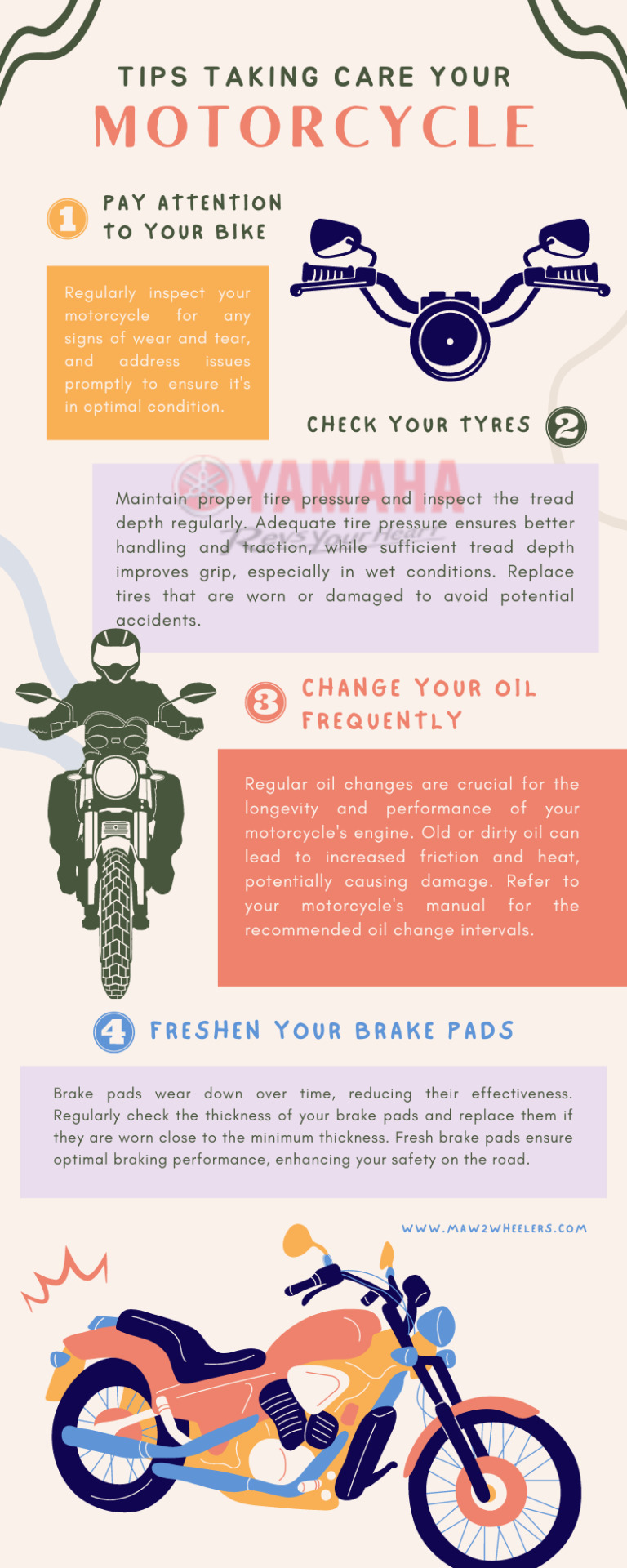
Motorcycle safety tips are for everyone, whether you're a seasoned motorcycle rider or an enthusiast. These simple yet effective tips are for everyone and they are going to make your life easier.
By maw2wheelers.com
0 notes
Text
5 Things to Know Before Buying a New Battery for Your Motorcycle!
The battery is one of the most crucial parts of the motorcycle, which means it should take up a number of your focus during every tune-up.
Nevertheless, when it is time to replace that old bike battery, there may often be some questions about all the various kinds and what all those designations and specifications mean.
Finding the proper battery can be essential to the motorcycle's performance, the lifetime of this battery life, and getting home from where you are going.
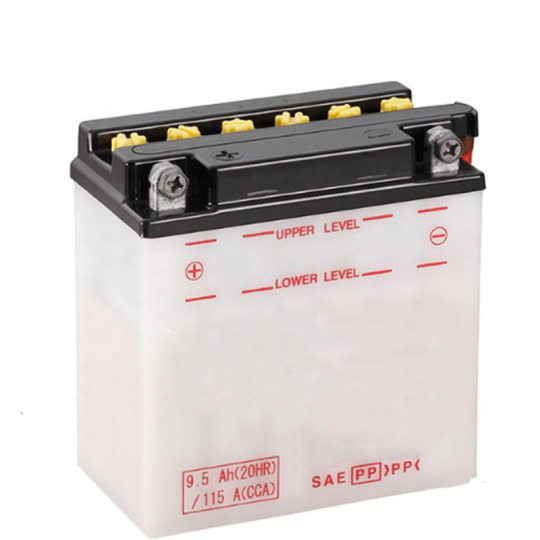
Get to know the very best five things about motorcycle batteries. Their science is going to keep you moving for miles in the future.
1. High CCA Provides Startup Reliability
Pay close attention to the CCA or even cold-cranking amps. This value should be 500 or higher, for instance. Choosing a high CCA provides the bike an opportunity to start under harsh conditions. It's sufficient current to trigger the engine at 0 degrees Fahrenheit. Typically, you won't wind up stranded with a high CCA on your motorcycle
These batteries do decrease over time, particularly if they are in storage, says How Stuff Works. Do not forget to have a convenient, bike battery charger available in the event of a power problem. Knowing how to control a motorcycle battery Can Help You get the bike back on the street
2. Pick Sealed Batteries
In the past, you did not have much of a choice when it arrived at a motorcycle battery. Flooded or wet-cell designs were the only option. Presently, you desire a design that requires the least maintenance which is referred to as the sealed battery.
Motorcycles take the brunt of the street's imperfections. Bumps stop and other sudden moves impact the battery over time. Flooded batteries have the tendency to leak, which leads to sulfating and slow decline. Start looking for AGM or gel motorcycle battery solutions, if available around. The sealed structure is going to be a reprieve from corroded terminals and shut-off water levels in older battery types.
3. Utilize a Replacement Kit Safely
The motorcycle-engine slot has limited space and updating or changing a battery to a different type might appear impossible.
You might want a better battery with the latest Motorcycle battery charger. Compare the brand new battery to the compartment on your ride. If the fit isn't right, you can always change the position. Or even better, look for a kit that converts the current distance to the new battery's dimensions. There is no reason why you cannot replace the old version with a new one on any motorcycle. There is almost always a creative solution.
4. Know the distinction between Lithium, AGM, Gel, or Traditional
A traditional battery is an old-school lead-acid type. They're the most economical option and available easily. But also require a little bit of upkeep. They are also unsafe as it is filled with corrosive acid.
Gel Batteries are like the next generation of standard batteries. Rather than liquid acid, a gel is used. They're typically used for deep cycle utilizes and not as starter batteries. The starter they’re dependable and last a long time. In a completely different direction, lithium batteries don't use any lead or acid.
5. Warranty
Look for a Battery that's backed by a manufacturer guarantee. That way if there is a Difficulty with it that you have somebody to turn to.
0 notes
Text
Motorcycle Handlebars - How they Impact Your Motorcycle Riding!
Motorcycle Handlebars have one job but they come in all shapes and sizes. This is because the geometry of a bike decides the rider's posture as well as the handling characteristics of a bike. And then there's the simple fact that having the ideal type of handlebar may earn a motorcycle look great. So let us take a look at the different types of bike handlebars and their objective.
Clip-on
A Clip-on handlebar comprises two bits that are individually mounted onto the front fork. It delivers a more sporty riding position together with the rider having to tilt over to the front to take control. A clip-on motorcycle handlebar is generally seen on bikes at the track, or on higher-end bikes on the roads that have a sporty dynamic to them. The riding position it generates is normally uncomfortable for leisurely riding, but significantly enhances the handling characteristics of a motorcycle. Clip-ons are two types. 1 set allows for alteration for the rider and all these are largely seen on track-spec bikes. The other set is repaired and is usually found on production motorcycles for the road.
Zero Drag
A zero You won't see many of these on production-spec bikes since they are somewhat more of a tuner's attachment. A straight bar has one advantage over other pubs, it offers great grip in the corners. So if you're looking to muscle a motorcycle to a corner, then a straight bar is going to be your biggest ally.
Z-Bar
This is The type of handlebar you may see on most budget bikes in India. It has a rise on the two ends which then angles towards the outside. The biggest reason to use it upon budget bikes is the fact that it offers a comfortable riding position for the rider, while still providing adequate steering. It is also used by custom bike stores on cruiser bikes, to increase the height of the handlebar over the elevation of the motorcycle. This type of handlebar is much better suited for leisurely riding.
Ape-hanger
You Won't find this kind of a handlebar on almost any production bike in India. It's so tall in its design a rider has to raise their hands to head height, just to have a grip on them. These don't provide any performance benefits, outside of the fact that they seem cool. You will see them on chop-shop motorcycles which have been customized to the stage that they're beyond familiar with.
Which handlebar should you go for?
If You are not looking for any performance gains from your motorcycle, we would suggest that you leave your motorcycle handlebar as it's. But if you are seeking to add a new dynamic for your riding, or are trying to find a bit more out of your bike in corners, is when we suggest you opt for handlebar customization. Clip-on is the usual answer but straight bars have been known to supply quite a few leverages in corners as well. In the end, each customization will be unique to each motorcycle and consequently, we propose thorough research before you go for a handlebar swap.
Also, make sure that you reach out to the right person to do this sort of employment. Changing A handlebar can impact things like the brake oil pressure on a bike, so Make sure that everything works in your motorcycle before heading home.
0 notes
Text
5 Important Tips to Avoid Motorcycle Accident – For Both Newbies and Seasoned Bikers
As motorcycle enthusiasts, many of us love nothing more than to get on the open road and explore on our bikes. However long you have been riding for, your health and security should naturally be the number one priority. When comparing the fatality rate for car accidents and motorcycle accidents, the latter would be greater than 26 times greater, meaning safety and safety should be your major concern.
Whether you are a newcomer or a seasoned biker, there are numerous precautionary measures that you could take to reduce the probability of crashing. Here are five ideas on how best to prevent a motorcycle collision.
Ride at an appropriate speed
Speeding on the open street might feel liberating and thrilling, however, not only are you placing yourself at risk but other drivers too. If you are riding in severe weather conditions, you might want to ride more cautiously.
Wear the appropriate gear
Wearing the proper safety equipment cannot just help make riding more comfortable, but also increase your visibility on the road, besides, maintaining your body protected from harm. Wearing a safety jacket or a vest that is reflective in a bright color will help ensure that drivers are aware of your presence, especially at nighttime. However many years of riding experience you have, you're not invincible, so you must always wear your helmet.
Prevent blind zones
Many injuries are a consequence of drivers being unable to see the motorcyclist in their side and rear-view mirrors. To remain out of the bind zone, you can do that by putting yourself towards the front of other vehicles, meaning you will be located within the driver's line of sight.
Stay vigilant
When riding on your motorcycle, it is crucial that you're on continuous alert, and assume that other drivers can't see you. When arriving at intersections and stop signs, you need to pay extra attention and care, as two-thirds of car and motorcycle accidents happen when a different vehicle infringes the bike's right away.
Maintain tires
Before heading out on your bike, you must make sure you’re routinely assessing your tires, lights, brakes, and exhaust system can't only put your head at ease but reduce the risk of a crash. In summertime particularly, roads can be treacherous, so keeping a close watch on your motorcycle is critical.
Get right motorcycle
Going for rightly appropriate and tested motorcycle with ergonomic comfort makes it way more safer and easier for the biker. Make sure you make good research and find the best motorcycle as per your requirements.
0 notes
Text
What is CC and how it affects your motorcycle riding?
A motorcycle's engine capacity Is vital as it directly relates to the level of power it generates. The capacity of a motorcycle's engine is measured concerning cubic capacity. Cubic capacity, also called"cc" of vehicles, typically ranges between 50cc to 1500cc. It's also considered that the larger chamber on a two-wheeler, the more powerful it is. The CC capacity is measured in a similar way as in the four-wheelers where the number of liters measures the capacity of the engine.
Thus, a two-wheeler with a motor capacity of 250cc has a capacity of 0.25 liters. On the other side, the motor power of the two-wheeler equally plays an important part in determining different engine outputs like torque, mileage, and electricity output.
The motor capacity is the space/ quantity available inside The tank to accommodate the air-fuel mix for burning. The larger the cylinder, the further mixing it can collect. Larger motorcycles normally have bigger containers, that is why they create more electricity and have more gas space: the engine power, the greater your gasoline bill. Generally, smaller engine capacity is more effective and provides more mileage for each litre of fuel.
The thing about choosing a bike you need to ride regarding the above-mentioned power too depends on the sort of usage the bike is going to be put to. For instance, if you want a bike specifically for extended highways hauls, then you may want something similar to a cruiser for relaxation and also the best engine capacity for good speeds as well. But if you only intend to ride inside the town, then a simple commuter works best because then you do not have to spend enormously on gasoline bills and can easily navigate traffic also.
How Engine Capacity influences CCs Performance?
Different Engine outputs such as power, torque, and mileage are calculated with the help of engine capacity. If the engine has a higher standing, then it usually means it will have more space inside the cylinder. The amount of fuel and the air within the air is obviously in proportionality. The energy output will be increased as the amount of gas-burning within the tank increases. Or we could say that the amount of production is proportional to the amount of fuel intake as well as the engine ability, however, an increase in gas consumption also leads to a decline in the mileage.
So what are the factors you should consider while determining the cc of your new machine? Here are some:
Maintenance Cost:
Greater the CC of the motorcycles, the more will be the maintenance cost. Low CC commuters are practical bikes. The motor isn't under much stress consequently making them pretty much low maintenance bikes. But the greater CC bikes are running motors under very large stress and thus it pretty much needs to be perfect else it will make a disaster in mid-running. So overall the expenditure on the maintenance also increases because the spares of these bikes are also fairly expensive.
Safety Standard:
Safety Whilst riding is important Concerning gears used. But with lower capacity bikes you can maybe bypass the riding jackets and trousers and sneakers to regular ones since you do not travel much fast on them. However, with higher capacity motorcycles, the care needed is more since you journey faster and hence the chances of accidents are also more including a higher amount of harm to you.
Riding Style:
Choosing a bike and caring for it also depends a Good Deal on your riding style. But then according to how you ride can also be dependent on how much you will have to care for your motorcycle. Not to mention your tyres. But on the other hand, if you're calm and composed when riding and treat your motorcycle in regard, then the very same costs will be less and hence you can enjoy your bike a lot better. But for smaller CC motorcycles, they anyways do not go much quickly so caring for these is very easy in this case.
Monthly Fuel Bills:
This Is why heavy commuters are asked to use high mileage motorcycles because the fuel bills are always a concern. You need to travel long distances, then spending substantial amounts on fuel doesn't make sense. So the best method is to just get commuter bikes for it. But if you want to go For higher CC motorcycles, the fuel invoices will be directly affected by the engine capacity. Make a note of this when deciding on the motorcycle. You to go fast enough in addition to return a nice degree of fuel economy.
Yamaha has a range of different CC motorcycles according to different requirements. Have a look.
0 notes